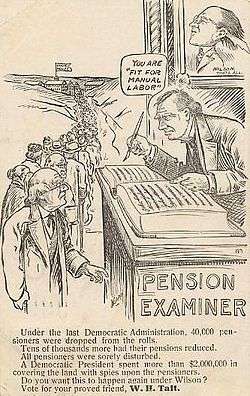Veteran's pension (United States)

A veteran's pension is a pension for veterans of the United States Armed Forces, who served in the military but did not qualify for military retired pay from the Armed Forces. It was established by the United States Congress and given to veterans who meet the eligibility requirements. Along with payments veterans are also given additional benefits depending on their eligibility and needs.
The veterans' pension system is managed by the Department of Veterans Affairs.
History
A pension plan for disabled veterans was established by congress in 1792.[1] Pension legislation for all surviving veterans was passed in 1818. This was unique to federal legislation. Money was shifted from the national treasury to individuals who were perceived as having the right to preferential treatment. The recipients were entitled to these payments because the pensions were viewed as delayed payments for the people who served during the American Revolution.[2]
Eligibility
Someone is generally eligible for veteran's pension if he or she
- Was not discharged for dishonorable reasons
- Served 90 days of active military duty, at least one of which was during a wartime period
- Had countable family income below a certain yearly limit
- Is 65 years or older, or is permanently disabled not due to willful misconduct[3]
Calculation
The annual pension is calculated by adding all of the person's countable income. Any deductions are then subtracted from that total. The remaining total is deducted from the maximum pension limit[4] (taking into account the number of dependents, spouse, etc.). This final number is the yearly pension; dividing it by 12 results in the monthly pension.[5]
Income received per month
- Married veterans- up to $2054 per month
- Single veterans- up to $1732 per month
- Surviving spouses- up to $1113 per month [6]
Additional benefits
In addition to monthly payments, certain veterans may be eligible for additional benefits such as automobile grants, special adaptive housing, traumatic service members group life insurance, educational benefits and health care. [7]
Aid and Attendance
Aid and Attendance is an amount awarded in addition to the basic pension. This benefit takes into account a person's unreimbursed (out-of-pocket) medical expenses. These medical expenses are subtracted from a person's gross income to determine eligibility.[8]
A veteran is eligible for Aid and Attendance when he or she
- Requires the regular aid of another person to perform everyday functions (bathing, eating, dressing, etc.)
- Is bedridden
- Is a patient in a nursing home
- Is blind or nearly blind
_officer_during_a_visit_to_Naval_Medical_Center_San_Diego_(NMCSD).jpg)
Housebound
A veteran is eligible for Housebound benefits when he or she
- Has a single permanent disability that results in the veteran's confinement to his or her immediate premises
- Has a single permanent disability rated as 100% disabling and a secondary disability rated as 60% disabling[9]
References
- ↑ "Hayburn's Case: Information from". Answers.com. Retrieved 2014-03-27.
- ↑ UMI Dissertation Services, ProQuest Information and Learning, Ann Arbor, MI, 2001. Source Note: From: Dissertation Abstracts International, Volume: 62-05, Section: A, page: 1925.Thesis (Ph.D.)--University of South Carolina, 2001.
- ↑ "Veterans Pension". Department of Veterans Affairs. Retrieved 2008-06-19.
- ↑ schedule
- ↑ "Military Benefits". Military.com. Retrieved 2007-03-10.
- ↑ "The Leading Veteran Pension Resource Site on the Net". veteranspensionresource.com. Retrieved 2014-03-27.
- ↑
- ↑ Adam J. Larson. "Qualifying for A&A Benefits". Veterans' Legal Aid Society. Retrieved 3 June 2010.
- ↑ "Veterans Pension". Department of Veterans Affairs. January 12, 2007. Retrieved 2007-03-10.